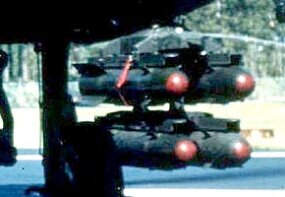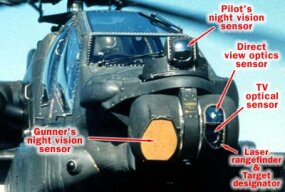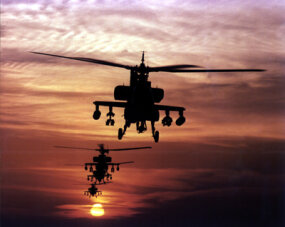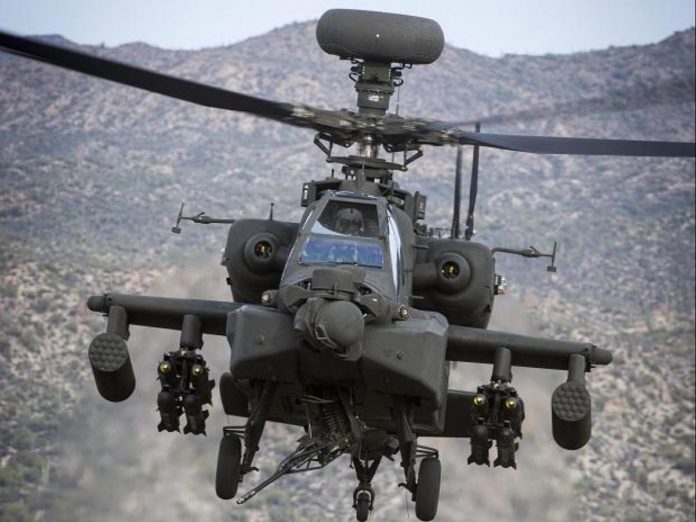The AH-64 Apache is the most advanced multi-role combat helicopter for the U.S. Army and a growing number of international defense forces.
An Advanced Multi-role Helicopter
The AH-64 Apache is the world’s most advanced multi-role combat helicopter and is used by the U.S. Army and a growing number of international defense forces. Boeing has delivered more than 2,200 Apaches to customers around the world since the aircraft entered production. The U.S. Army Apache fleet has accumulated (as of July 2016) more than 4.2 million flight hours since the first AH-64A was delivered to the U.S. Army in January 1984.
AH-64E Apache Technical Specifications
| Length | Maximum Level Flight Speed |
| Height | 15.24 ft (4.64 m) |
| Wing Span | 17.15 ft (5.227 m) |
| Primary Mission Gross Weight | 15,075 lb (6,838 kg) |
| Vertical Rate of Climb | More than 2,000 ft per minute |
| Maximum Rate of Climb | More than 2,800 ft per minute |
| Maximum Level Flight Speed | More than 150 knots (279 kilometers per hour) |
How Apache Helicopters Work
The Apache helicopter is a revolutionary development in the history of war. It is essentially a flying tank — a helicopter designed to survive heavy attack and inflict massive damage. It can zero in on specific targets, day or night, even in terrible weather. As you might expect, it is a terrifying machine to ground forces.
In this article, we’ll look at the Apache’s amazing flight systems, weapons systems, sensor systems and armor systems. Individually, these components are remarkable pieces of technology. Combined together, they make up an unbelievable fighting machine — the most lethal helicopter ever created.
At its core, an Apache works pretty much the same way as any other helicopter. It has two rotors that spin several blades. A blade is a tilted airfoil, just like an airplane wing. As it speeds through the air, each blade generates lift. The main rotor, attached to the top of the helicopter, spins four 20-foot (6-meter) blades. The pilot maneuvers the helicopter by adjusting a swash plate mechanism. The swash plate changes each blade’s pitch (tilt) to increase lift. Adjusting the pitch equally for all blades lifts the helicopter straight up and down. Changing the pitch as the blades make their way around the rotation cycle creates uneven lift, causing the helicopter to tilt and fly in a particular direction.
Apache Rotors and Blades
The newest Apache sports twin General Electric T700-GE-701C turboshaft engines, boasting about 1,700 horsepower each. Each engine turns a drive shaft, which is connected to a simple gear box. The gear box shifts the angle of rotation about 90 degrees and passes the power on to the transmission. The transmission transmits the power to the main rotor assembly and a long shaft leading to the tail rotor. The rotor is optimized to provide much greater agility than you find in a typical helicopter.
The core structure of each blade consists of five stainless steel arms, called spars, which are surrounded by a fiberglass skeleton. The trailing edge of each blade is covered with a sturdy graphite composite material, while the leading edge is made of titanium. The titanium is strong enough to withstand brushes with trees and other minor obstacles, which is helpful in “nap-of-the-earth” flying (zipping along just above the contours of the ground). Apaches need to fly this way to sneak up on targets and to avoid attack. The rear tail wing helps stabilize the helicopter during nap-of-the-earth flight as well as during hovering.
Apache Hellfire Missiles
The Apache’s primary weapon, the Hellfire missile, meets these demands. Each missile is a miniature aircraft, complete with its own guidance computer, steering control and propulsion system. The payload is a high-explosive, copper-lined-charge warhead powerful enough to burn through the heaviest tank armor in existence.
The Apache carries the missiles on four firing rails attached to pylons mounted to its wings. There are two pylons on each wing, and each pylon can support four missiles, so the Apache can carry as many as 16 missiles at a time. Before launching, each missile receives instructions directly from the helicopter’s computer. When the computer transmits the fire signal, the missile sets off the propellant. Once the burning propellant generates about 500 pounds of force, the missile breaks free of the rail. As the missile speeds up, the force of acceleration triggers the arming mechanism. When the missile makes contact with the target, an impact sensor sets off the warhead.
The original Hellfire design uses a laser guidance system to hit its mark. In this system, the Apache gunner aims a high-intensity laser beam at the target (in some situations, ground forces might operate the laser instead). The laser pulses on and off in a particular coded pattern.

Before giving the firing signal, the Apache computer tells the missile’s control system the specific pulse pattern of the laser. The missile has a laser seeker on its nose that detects the laser light reflecting off the target. In this way, the missile can see where the target is. The guidance system calculates which way the missile needs to turn in order to head straight for the reflected laser light. To change course, the guidance system moves the missile’s flight fins. This is basically the same way an airplane steers.
- Cloud cover or obstacles can block the laser beam so it never makes it to the target.
- If the missile passes through a cloud, it can lose sight of the target.
- The helicopter (or a ground targeting crew) has to keep the laser fixed on the target until the missile makes contact. This means the helicopter has to be out in the open, vulnerable to attack.
The Hellfire II, used in Apache Longbow helicopters, corrects these flaws. Instead of a laser-seeking system, the missile has a radar seeker. The helicopter’s radar locates the target, and the missiles zero in on it. Since radio waves aren’t obscured by clouds or obstacles, the missile is more likely to find its target. Since it doesn’t have to keep the laser focused on the target, the helicopter can fire the missile and immediately find over.
Apache Sensors
The pilot and the gunner both use night vision sensors for night operations. The night vision sensors work on the forward-looking infrared (FLIR) system, which detects the infrared light released by heated objects. (See How Night Vision Works for more information.)
The pilot’s night vision sensor is attached to a rotating turret on top of the Apache’s nose. The gunner’s night vision sensor is attached to a separate turret on the underside of the nose. The lower turret also supports a normal video camera and a telescope, which the gunner uses during the day.

Apache Evasion Tactics and Armor
The Apache is also designed to evade heat-seeking missiles by reducing its infrared signature (the heat energy it releases). The Black Hole infrared suppression system dissipates the heat of the engine exhaust by mixing it with air flowing around the helicopter. The cooled exhaust then passes through a special filter, which absorbs more heat. The Longbow also has an infrared jammer, which generates infrared energy of varying frequencies to confuse heat-seeking missiles.
The Apache is heavily armored on all sides. Some areas are also surrounded by Kevlar soft armor for extra protection. The cockpit is protected by layers of reinforced armor and bulletproof glass. According to Boeing, every part of the helicopter can survive 12.7-mm rounds, and vital engine and rotor components can withstand 23-mm fire.
The area surrounding the cockpit is designed to deform during collision, but the cockpit canopy is extremely rigid. In a crash, the deformation areas work like the crumple zones in a car — they absorb a lot of the impact force, so the collision isn’t as hard on the crew. The pilot and gunner seats are outfitted with heavy Kevlar armor, which also absorbs the force of impact. With these advanced systems, the crew has an excellent chance of surviving a crash.

For more information about Apache helicopters and other weapons, check out the links below.
The AH-64 Apache is used by the widely by the US Army and a number of defence forces of other countries. This attack helicopter is equipped with a 30-mm machine gun and is capable of firing up to 1,200 rounds at a time. The AH-64 Apache helicopter comes equipped with the anti-tank Hellfire missile, which is believed to be capable of destroying a tank. As an additional weapon, a Hydra Unguided Rocket, capable of perfect execution of any target on land, is also installed. The helicopter can fly at a speed of 150 nautical miles per hour, which helps it to reach the enemy at a tremendous speed in the air.
In a major boost to the Indian Air Force, eight Boeing AH- 64E Apache Guardian Attack Helicopters were inducted into the force on Tuesday. IAF chief Air Chief Marshal BS Dhanoa inducted the choppers officially into the service after a ceremony held at the Pathankot Air Force Station. Eight helicopters have been inducted into the air force in the first batch out of the 22 procured from the US. In September 2015, IAF had signed a contract with US Government and Boeing for these Apache helicopters. The delivery of the whole lot is expected to be completed by 2020, as stated in the contract.






















































